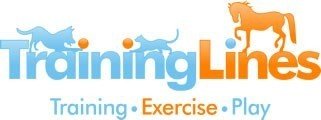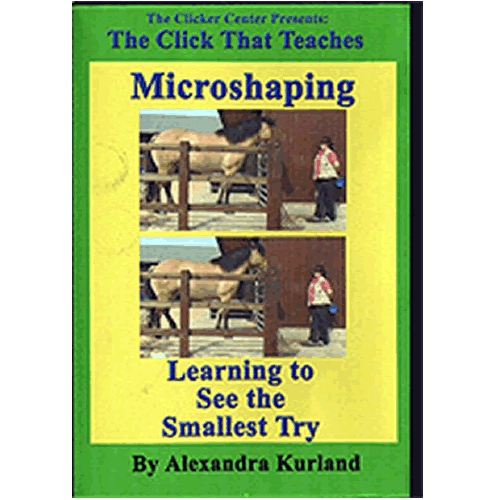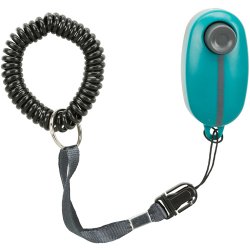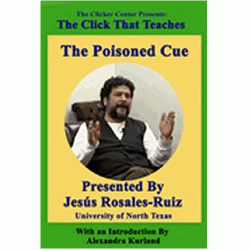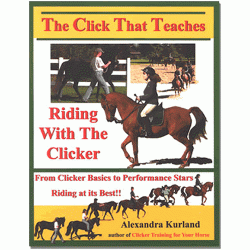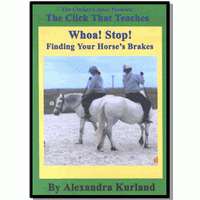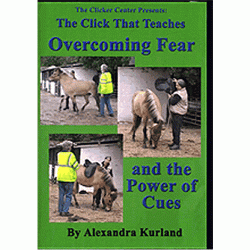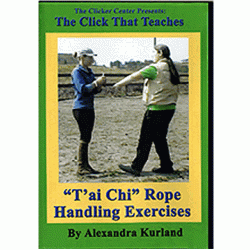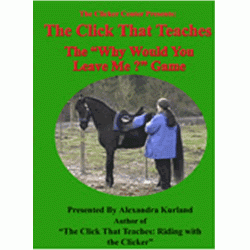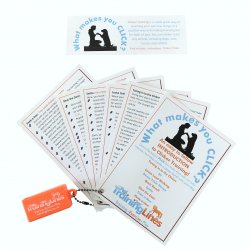DVD Lesson 10: Microshaping by Alexandra Kurland
In this Alexandra Kurland DVD, learn to see small details in movement and how to put those tiny shifts in balance to work for you to calm herd-bound horses, manage separation anxiety, create beautiful gaits, and maintain long term soundness. Microshaping is "Equine Pilates" - Shaping for a Sound Spine.
Approx 2 hours.
-
Delivery info
We are delighted to ship our products within the UK, and throughout Europe and the rest of the world
-
Payment methods
Pay securely online through PayPal (a PayPal account is not required), or contact us.

-
Returns
We accept returns
Shaping is the backbone of clicker training. When we click the clicker to highlight a desired behavior in our horses we are shaping behavior. We are selectively reinforcing that behavior making it more likely that the horse will repeat it in the future. From the very first lesson in targeting you have been learning how to shape behavior with the clicker.
The question is: are you a good shaper? Do you see small details of movement and do you know how to use them? Are you a splitter of behavior or a lumper? Splitters see detail. They train in tiny steps which makes it easier for their horses to learn from them. Lumpers ask for too much too fast. This often creates frustration and confusion in their horses. Nowhere is this seen more clearly than in freeshaping.
When you freeshape you are not luring the behavior with targets or triggering it in any other way through your direct actions. You are simply observing your animal and marking desired responses with a click and a treat.
Microshaping is a term coined by the UK dog trainer, Kay Lawrence. It refers to splitters versus lumpers. Microshaping lets you maintain high rates of reinforcement by looking at the underlying reaction patterns that create complex movements. Kay Lawrence began exploring microshaping because she was concerned by what she saw in the canine clicker community. People were taking too many shortcuts to get to their end goal. They were creating frustrated, anxious learners and the behavior they were ending up with in the show rings was many times biomechanically incorrect.
So Kay started looking at the underlying reaction patterns that went into the movements these handlers were trying to shape. In other words, what happens just before a dog sits, or backs up? Can you see the small movement that predicts the larger target behavior? When Kay taught her students to train using microshaping, she saw improved learning success and much happier dogs.
Micromovements are at the core of single-rein riding, so Kay's work certainly got my attention. One of the many things she stressed in microshaping was the need for a high rate of reinfocement. With the dogs she trained in short trials, a minute at a time for a session, but in that minute the dog experienced a high rate of success because it was being reinforced for such tiny increments of improvement. The result was happy, eager dogs who very much understood and could reproduce reliably a very high quality of performance.
Such short training sessions don't seem very practical with horses, and at times they aren't even possible. At clinics I am often working with horses who are falling apart emotionally. They are in an unfamiliar environment, away from their pasture mates, and they are afraid. We can't easily work them for a minute and then put them away. We need to keep these horses engaged with us to keep them safe. But an upset horse can be a challenge to work with. Their focus is outside the ring. It's all on leaving, getting back to the security of their home herd.
Figuring out safe, clicker-compatible ways to work with these upset horses was the origin of the microshaping strategy that is featured on this DVD. You'll learn how to bring an anxious horse's focus back onto you by simply slouching against the side of his pen and watching for micromovements to click. No chasing him around round pens, no driving his feet into motion. The motto for this style of training could easily be: why sweat when you can slouch?
The microshaping strategy is an excellent way for handlers to learn to see detail. That makes it a perfect DVD to watch before you launch into the single-rein riding techniques taught in the later DVDs. Single-rein riding is all about seeing detail.
This DVD will show you not only how to see detail, but also how to use it to create beautiful balance. It introduces you to "Equine Pilates", to shaping for a sound spine.
Approx 2 hours.
Click Here to read what Alexandra Kurland says about her series of clicker training books and DVDs, and how to get the best from the lesson sequence.
We are delighted to ship our products within the UK, and throughout Europe and the rest of the world, and we make it a priority to dispatch as quickly as we can. 98% of orders are on their way within 24 hours (Mon-Fri) and almost 100% within a couple of days.
Most UK orders are delivered by Royal Mail, Parcel Force, or Hermes, and once you have entered your address and postcode information (or signed in), you will be presented with one or more delivery options.
For international orders, we choose the most appropriate carrier depending on a number of factors. Not all of our products are suitable for international shipping, and size and weight restrictions may apply. If we are unable to send one or more of your order items, we are always happy to discuss alternative options with you.
Click below for more details:
Some products are marked as 'UK Delivery Only' or have similar restrictions. For delivery in another region, please contact us before ordering so that we can advise you on the options available.
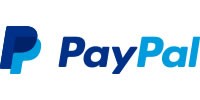
Pay securely through PayPal. A PayPal account is not required.
Prefer to speak to a person? No Problem! Simply select 'Contact Us' at the checkout, and call us with your payment details after you submit your order.
If you would like to return your item(s) to us, you are welcome to do so and can post them to the address on the reverse of your Invoice/Delivery Note. Please retain proof of posting.
We ask that you let us know in advance if you can, and package them securely so that they arrive undamaged. Please also include a note that explains who you are, your order number, and how you would like us to handle your return (whether you would like a refund or an exchange, for example). A copy of your Invoice/Delivery note would be fine.
It would also help us to know why you are returning your item(s), but this is entirely optional.
There are exceptions. We cannot accept returns of 'Special Order' or bespoke items, for example (such as imprinted clickers), and some other restrictions do apply. Please see our full Terms and Conditions.
Not sure what to do? Please contact us.

